Recent Highlights
Identifying a Proto-Super Star Cluster
 Super star clusters (SSCs) are considered to be the birth zones of stellar globular clusters, and a key aspect of star formation in galaxies. Johnson et al. have used ALMA and the VLA to identify the youngest such system: a 24 parsec radius molecular cloud with a molecular gas mass > 5 x 106 M⊙, in the Antennae merging galaxy system. This proto-SSC has yet to initiate star formation. They conclude that the clouds must be short-lived (< 1 Myr), and pressure-confined by a medium with 104 times typical interstellar medium (ISM) pressures.
Super star clusters (SSCs) are considered to be the birth zones of stellar globular clusters, and a key aspect of star formation in galaxies. Johnson et al. have used ALMA and the VLA to identify the youngest such system: a 24 parsec radius molecular cloud with a molecular gas mass > 5 x 106 M⊙, in the Antennae merging galaxy system. This proto-SSC has yet to initiate star formation. They conclude that the clouds must be short-lived (< 1 Myr), and pressure-confined by a medium with 104 times typical interstellar medium (ISM) pressures.
Image: ALMA and VLA images of the molecular gas and thermal continuum emission in the proto-superstar cluster in the Antennae galaxies
Science Team: K.E. Johnson (University of Virginia), A.K. Leroy (NRAO), R. Indebetouw (University of Virginia, NRAO), C.L. Brogan (NRAO), B.C. Whitmore (STScI), J. Hibbard (NRAO), K. Sheth (NRAO), and A.S. Evans (University of Virginia, NRAO).
Publication: The Physical Conditions in a Pre-super Star Cluster Molecular Cloud in the Antennae Galaxies, 2015, Astrophysical Journal, 806, 35.
Astrochemistry of a Starburst
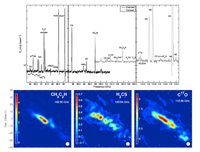 Meier et al. present a 50 parsec resolution imaging study of molecular gas species in the central kiloparsec of the nearby starburst galaxy NGC 253 based on ALMA observations. More than 50 emission lines are seen from more than 30 complex molecules emitting at 86 – 115 GHz (ALMA 3mm band). The dramatic variation seen in the HNCO / SiO line ratio suggests that some of the chemical signatures of shocked gas are being erased in the presence of dominating central radiation fields (traced by C2H and CN). High-density molecular gas tracers – including HCN, HCO+, and CN – are detected at the base of the molecular outflow, driven by the starburst.
Meier et al. present a 50 parsec resolution imaging study of molecular gas species in the central kiloparsec of the nearby starburst galaxy NGC 253 based on ALMA observations. More than 50 emission lines are seen from more than 30 complex molecules emitting at 86 – 115 GHz (ALMA 3mm band). The dramatic variation seen in the HNCO / SiO line ratio suggests that some of the chemical signatures of shocked gas are being erased in the presence of dominating central radiation fields (traced by C2H and CN). High-density molecular gas tracers – including HCN, HCO+, and CN – are detected at the base of the molecular outflow, driven by the starburst.
Image: ALMA spectrum and molecular line images of the starburst nucleus of NGC 253
Science Team: David S. Meier (New Mexico Tech, NRAO), Fabian Walter (Max-Planck Institut für Astronomie, NRAO), Alberto D. Bolatto (Maryland), Adam K. Leroy (NRAO), Jürgen Ott (NRAO), Erik Rosolowsky (Univerfity of Alberta), Sylvain Veilleux (University of Maryland), Steven R. Warren (University of Maryland), Axel Weiß (Max-Planck Institut für Astronomie), Martin A. Zwann (ESO), and Laura K. Zschaechner (Max-Planck Institut für Astronomie).
Publication: ALMA Multi-line Imaging of the Nearby Starburst NGC 253, 2015, Astrophysical Journal, 801, 63.
Physics and Dynamics of the First Galaxies
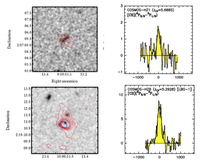 The sensitivity of ALMA has opened up a new era in the study of galaxy formation through the use of the strong atomic fine structure lines coming from the cool ISM, in particular, the [CII] 158 micron line. This is the strongest emission line from star-forming galaxies from the far infrared through the radio, and is the dominant cooling mechanism for cool interstellar gas. This line redshifts into the ALMA bands at z > 1. Capak et al. have detected [CII] in samples of typical star-forming galaxies – star formation rates of a few to 100 M⊙ per year – at z = 5.2 to 6.2. This represents a new window on galaxy formation in terms of studying gas dynamics and dark matter, ISM physics, and determining redshifts for the first galaxies.
The sensitivity of ALMA has opened up a new era in the study of galaxy formation through the use of the strong atomic fine structure lines coming from the cool ISM, in particular, the [CII] 158 micron line. This is the strongest emission line from star-forming galaxies from the far infrared through the radio, and is the dominant cooling mechanism for cool interstellar gas. This line redshifts into the ALMA bands at z > 1. Capak et al. have detected [CII] in samples of typical star-forming galaxies – star formation rates of a few to 100 M⊙ per year – at z = 5.2 to 6.2. This represents a new window on galaxy formation in terms of studying gas dynamics and dark matter, ISM physics, and determining redshifts for the first galaxies.
Image: [CII] 158 micron emission and thermal dust emission from z ~ 5.5 galaxies
Science Team: P.L. Capak (IPAC, Caltech), C. Carilli (NRAO, Cavendish), G. Jones (New Mexico Tech), C.M. Casey (University of Texas), D. Riechers (Cornell University), K. Sheth (NRAO), C.M. Carollo (ETH Zurich), O. Ilbert (CNRS), A. Karim (Argelander Institute für Astronomie), O. LeFevre (CNRS), S. Lilly (NRAO), N. Scovill (Caltech), V. Smolcic (University of Zagreb), and L. Yan (IPAC, Caltech).
Publication: Galaxies at Redshifts 5 to 6 with Systematically Low Dust Content and High [C II] Emission, 2015, Nature 522, 455.
A Pulsar Orbiting the Galactic Center
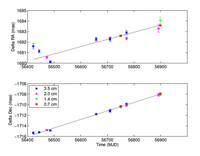 Bower et al. used the VLBA to determine the proper motion of pulsar J1745-2900 relative to the Galactic Center. The pulsar has a transverse velocity of 236 ± 11 km/s at a projected separation of 0.097 parsecs from Sgr A*. The angular broadening with frequency is similar to Sgr A*. The velocity and position is consistent with a bound orbit originating in the clockwise disk of massive stars orbiting Sgr A* and a natal velocity kick of < 500 km/s. These results for PSR J1745-2900 support the hypothesis that Galactic Center pulsars can originate in the inner stellar disk, and deepens the mystery regarding the small number of detected Galactic Center pulsars to date.
Bower et al. used the VLBA to determine the proper motion of pulsar J1745-2900 relative to the Galactic Center. The pulsar has a transverse velocity of 236 ± 11 km/s at a projected separation of 0.097 parsecs from Sgr A*. The angular broadening with frequency is similar to Sgr A*. The velocity and position is consistent with a bound orbit originating in the clockwise disk of massive stars orbiting Sgr A* and a natal velocity kick of < 500 km/s. These results for PSR J1745-2900 support the hypothesis that Galactic Center pulsars can originate in the inner stellar disk, and deepens the mystery regarding the small number of detected Galactic Center pulsars to date.
Image: Position as a function of time for PSR J1745-2900 relative to Sgr A*
Science Team: Geoffrey C. Bower (ASIAA), Adam Deller (ASTRON), Paul Demorest (NRAO), Andreas Brunthaler (Max-Planck Institut für Radioastronomie), Heino Falcke (ASTRON, Max-Planck Institut für Radioastronomie, Radboud University), Monike Moscibrodzka (Radboud University), Ryan M. O’Leary (JILA), Ralph P. Eatough (Max-Planck Institut für Radioastronomie), Michael Kramer (Max-Planck Institut für Astronomie, Jodrell Bank), K.J. Lee (Max-Planck Institut für Radiostronomie), Laura Spitler (Max-Planck Institut für Radiostronomie), Gregory Desvignes (Max-Planck Institut für Radiostronomie), Anthony P. Rushton (University of Oxford, University of Southampton), Sheperd Doeleman (MIT Haystack Observatory, Harvard-Smithsonian Center for Astrophysics), and Mark J. Reid (Harvard-Smithsonian Center for Astrophysics).
Publication: The Proper Motion of the Galactic Center Pulsar Relative to Sagittarius A*, 2015, Astrophysical Journal, 798, 120.
The Structure of the Outer Galaxy
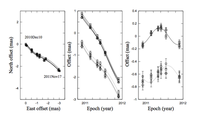 Hachisuka et al. report parallaxes and proper motions of three water maser sources in high-mass star-forming regions in the Outer Spiral Arm of the Milky Way. The observations were conducted with the VLBA as part of Bar and Spiral Structure Legacy Survey (BeSSeL) and double the number of such measurements in the literature. The Outer Arm has a pitch angle of 14.9° ± 2.7° and a Galactocentric distance of 14.1 ± 0.6 kiloparsecs toward the Galactic anti-center. The average motion of these sources toward the Galactic Center is 10.7 ± 2.1 km s-1, and there is no sign of a significant fall in the rotation curve out to 15 kiloparsecs from the Galactic Center. The three-dimensional locations of these star-forming regions are consistent with a Galactic warp of several hundred parsecs from the plane.
Hachisuka et al. report parallaxes and proper motions of three water maser sources in high-mass star-forming regions in the Outer Spiral Arm of the Milky Way. The observations were conducted with the VLBA as part of Bar and Spiral Structure Legacy Survey (BeSSeL) and double the number of such measurements in the literature. The Outer Arm has a pitch angle of 14.9° ± 2.7° and a Galactocentric distance of 14.1 ± 0.6 kiloparsecs toward the Galactic anti-center. The average motion of these sources toward the Galactic Center is 10.7 ± 2.1 km s-1, and there is no sign of a significant fall in the rotation curve out to 15 kiloparsecs from the Galactic Center. The three-dimensional locations of these star-forming regions are consistent with a Galactic warp of several hundred parsecs from the plane.
Image: VLBA parallax and proper motion measurements of maser spot in G097.53+0318 in the outer galaxy.
Science Team: K. Hachisuka (Yamaguchi University, Shanghai Astronomical Observatory), Y.K. Choi (Korean Astronomy and Space Institute), M.J. Reid (Harvard-Smithsonian Center for Astrophysics), A. Brunthaler (Max-Planck Institut für Radioastronomie), K.M. Menten (Max-Planck Institut für Radioastronomie), A. Sanna (Max-Planck Institut für Radioastronomie), and T.M. Dame (Harvard-Smithsonian Center for Astrophysics).
Publication: Parallaxes of Star-forming Regions in the Outer Spiral Arm of the Milky Way, 2015, Astrophysical Journal, 800, 2.
Fast Radio Bursts
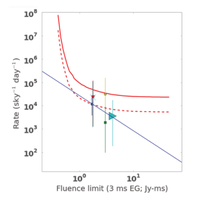 FRBs are millisecond radio bursts identified in single dish observations, but as yet not localized on the sky to any accuracy, nor associated with any astrophysical object. These sources could originate at cosmological distances, possibly signifying the death of binary neutron stars, and hence present critical cosmological probes. However, localization is crucial. Law et al. have searched for the enigmatic Fast Radio Bursts (FRBs), with the VLA. These VLA observations demonstrate the ability to perform imaging searches on timescales of 5 milli-seconds over 166 hours at 1.4 GHz, to a depth of 15 mJy, using a spectral mode of 256 x 1 MHz channels. Thus far, no FRB has been detected, and the limits are approaching that expected for the areal and temporal density of the sources.
FRBs are millisecond radio bursts identified in single dish observations, but as yet not localized on the sky to any accuracy, nor associated with any astrophysical object. These sources could originate at cosmological distances, possibly signifying the death of binary neutron stars, and hence present critical cosmological probes. However, localization is crucial. Law et al. have searched for the enigmatic Fast Radio Bursts (FRBs), with the VLA. These VLA observations demonstrate the ability to perform imaging searches on timescales of 5 milli-seconds over 166 hours at 1.4 GHz, to a depth of 15 mJy, using a spectral mode of 256 x 1 MHz channels. Thus far, no FRB has been detected, and the limits are approaching that expected for the areal and temporal density of the sources.
Image: Limits to the event rate of Fast Radio Bursts from the VLA imaging search (red curve, 95% confidence). The blue curve shows the expected rate.
Science Team: Casey J. Law (UC, Berkeley), Geoffry C. Bower (ASIAA), Sarah Burke-Spolaor (JPL, NRAO), Bryan Butler (NRAO), Earl Lawrence (Los Alamos), T. Joseph W. Lazio (JPL), Chris Mattmann (JPL), Michael Rupen (NRC Herzberg), Andrew Siemon (UC, Berkeley), and Scott VanderWiel (Los Alamos).
Publication: A Millisecond Interferometric Search for Fast Radio Bursts with the Very Large Array, 2015, Astrophysical Journal, 807, 16.
First Results from THOR
 To study giant molecular clouds (GMCs) in our Galaxy, the authors initiated a large VLA program: The H i, OH, Recombination line survey of the Milky Way (THOR). THOR maps the 21 cm H I line, 4 OH lines, up to 19 Hα recombination lines and the 1-2 GHz continuum over a significant fraction of the Milky Way at ~20” angular resolution. This paper focuses on the H I emission from the W43 GMC complex. The authors analyzed strong continuum sources to measure the optical depth along the line-of-sight and correct the HI emission for optical depth effects and weak diffuse continuum emission. Their analysis reveals a lower limit for the H I mass of 6.6 × 106 M⊙, a factor of 2.4 larger than the mass estimated with the assumption of optically thin emission. The H I column densities are as high as ~ 150 M⊙ pc-2, an order of magnitude higher than for low-mass star formation regions. This result challenges theoretical models that predict a H I column density threshold of ~10 M⊙ pc-2, at which the formation of molecular hydrogen should set in. For the atomic gas particle density, the authors find a linear decrease toward the center of W43 with n(HI) = 20 cm-3 near the cloud edge, and decreasing to almost 0 cm-3 at its center. The molecular hydrogen traced via dust observations with Herschel shows an exponential increase toward the center with densities increasing to n(H2) > 200 cm-3, averaged over a region of ~10 pc. While atomic and molecular hydrogen are well mixed at the cloud edge, the cloud center is strongly dominated by H2 emission. There is no sharp transition between hydrogen in atomic and molecular form. These results, which challenge current theoretical models, are an important characterization of the atomic to molecular hydrogen transition in an extreme environment.
To study giant molecular clouds (GMCs) in our Galaxy, the authors initiated a large VLA program: The H i, OH, Recombination line survey of the Milky Way (THOR). THOR maps the 21 cm H I line, 4 OH lines, up to 19 Hα recombination lines and the 1-2 GHz continuum over a significant fraction of the Milky Way at ~20” angular resolution. This paper focuses on the H I emission from the W43 GMC complex. The authors analyzed strong continuum sources to measure the optical depth along the line-of-sight and correct the HI emission for optical depth effects and weak diffuse continuum emission. Their analysis reveals a lower limit for the H I mass of 6.6 × 106 M⊙, a factor of 2.4 larger than the mass estimated with the assumption of optically thin emission. The H I column densities are as high as ~ 150 M⊙ pc-2, an order of magnitude higher than for low-mass star formation regions. This result challenges theoretical models that predict a H I column density threshold of ~10 M⊙ pc-2, at which the formation of molecular hydrogen should set in. For the atomic gas particle density, the authors find a linear decrease toward the center of W43 with n(HI) = 20 cm-3 near the cloud edge, and decreasing to almost 0 cm-3 at its center. The molecular hydrogen traced via dust observations with Herschel shows an exponential increase toward the center with densities increasing to n(H2) > 200 cm-3, averaged over a region of ~10 pc. While atomic and molecular hydrogen are well mixed at the cloud edge, the cloud center is strongly dominated by H2 emission. There is no sharp transition between hydrogen in atomic and molecular form. These results, which challenge current theoretical models, are an important characterization of the atomic to molecular hydrogen transition in an extreme environment.
View Paper: THOR: The HI, OH, Recombination line survey of the Milky Way: H I observations of the giant molecular cloud W43⋆, S. Bihr (MPIfA), H. Beuther (MPIfA), J. Ott (NRAO), K. G. Johnston (Leeds), A. Brunt haler (MPIfR), L. D. Anderson (WVU), F. Bigiel (Heidelberg), P. Carlhoff (Köln), E. Churchwell (Wisconsin), S. C. O. Glover (Heidelberg), P. F. Goldsmith (JPL), F. Heitsch (North Carolina), T. Henning (MPIfA), M. H. Heyer (Massachusetts), T. Hill (JAO), A. Hughes (MPIfA), R. S. Klessem (Heidelberg, Stanford, UC-Santa Cruz), H. Linz (MPIfA), S. N. Longmore (Liverpool), N. M. McClure-Griffiths (ATNF), K. M. Mentn (MPIfR), F. Motte (CEA/Saclay), Q. Nguyen-Luong (Toronto), R. Plume (Calgary), S. E. Ragan (MPIfA), N. Roy (MPIfR, Indian Institute of Technology), P. Schilke (Köln), N. Schneider (Bordeaux), R. J. Smith (Heidelberg), J. M. Stil (Calgary), J. S. Urquhart (MPIfR), A. J. Walsh (Curtin), and F. Walter (MPIfA), 2015 A&A, 580, A112 (published online 11 August 2015).
Imaging Diffuse Galactic HI Clouds
 A set of diffuse interstellar clouds in the inner Galaxy within a few hundred parsecs of the Galactic plane has been observed at an angular resolution of 1 arcminute (~ 2 pc), combining data from the GBT and the VLA. These clouds were selected to be somewhat outside the Galactic plane, and thus are not confused with unrelated emission, but in other respects they are a Galactic population. They are located near the tangent points in the inner Galaxy, and thus at a quantifiable distance, between 2.3 and 6.0 kpc from the Galactic Center and between -1000 and +610 parsecs from the Galactic plane. These are the first images of the diffuse neutral H i clouds that may constitute a considerable fraction of the interstellar medium (ISM). Peak H I column densities lie in the range N(HI) = 0.8 - 2.9 x 1020 cm-2. Cloud diameters vary between about 10 and 100 pc, and their H i mass spans the range from less than a hundred to a few thousands M⊙. The clouds show no morphological consistency of any kind, except that their shapes are highly irregular. One cloud may lie within the hot wind from the nucleus of the Galaxy, and some clouds show evidence of two distinct thermal phases as would be expected from equilibrium ISM models.
A set of diffuse interstellar clouds in the inner Galaxy within a few hundred parsecs of the Galactic plane has been observed at an angular resolution of 1 arcminute (~ 2 pc), combining data from the GBT and the VLA. These clouds were selected to be somewhat outside the Galactic plane, and thus are not confused with unrelated emission, but in other respects they are a Galactic population. They are located near the tangent points in the inner Galaxy, and thus at a quantifiable distance, between 2.3 and 6.0 kpc from the Galactic Center and between -1000 and +610 parsecs from the Galactic plane. These are the first images of the diffuse neutral H i clouds that may constitute a considerable fraction of the interstellar medium (ISM). Peak H I column densities lie in the range N(HI) = 0.8 - 2.9 x 1020 cm-2. Cloud diameters vary between about 10 and 100 pc, and their H i mass spans the range from less than a hundred to a few thousands M⊙. The clouds show no morphological consistency of any kind, except that their shapes are highly irregular. One cloud may lie within the hot wind from the nucleus of the Galaxy, and some clouds show evidence of two distinct thermal phases as would be expected from equilibrium ISM models.
View Paper: High Resolution Images of Diffuse Neutral Clouds in the Milky Way, I. Observations, Imaging, and Basic Cloud Properties, Y. Pidopryhora (Tasmania, Argelander), Felix J. Lockman (NRAO), J.M. Dickey (Tasmania), and M.P. Rupen (NRAO, DRAO) 2015 ApJS, 219, 16 (August 2015).
VLA Discovers Brown Dwarf Exo-aurora
 Aurorae are detected from all the magnetized planets in our Solar System. They are powered by magnetospheric current systems that lead to the precipitation of energetic electrons into the high-latitude regions of the upper atmosphere. In the case of the gas-giant planets, these aurorae include highly polarized radio emission at kilohertz and megahertz frequencies produced by the precipitating electrons, as well as continuum and line emission in the infrared, optical, ultraviolet and X-ray parts of the spectrum, associated with the collisional excitation and heating of the hydrogen-dominated atmosphere.
Aurorae are detected from all the magnetized planets in our Solar System. They are powered by magnetospheric current systems that lead to the precipitation of energetic electrons into the high-latitude regions of the upper atmosphere. In the case of the gas-giant planets, these aurorae include highly polarized radio emission at kilohertz and megahertz frequencies produced by the precipitating electrons, as well as continuum and line emission in the infrared, optical, ultraviolet and X-ray parts of the spectrum, associated with the collisional excitation and heating of the hydrogen-dominated atmosphere.
Using the VLA, Keck, and Palomar, Hallinan et al have discovered auroral emission from the M8.5 brown dwarf J1835+3259, located 5.7pc from Earth. VLA dynamic spectra show circularly polarized cyclotron emission 104 stronger than Jovian auroral emission, with B ~ 2000G. The aurora may indicate a star-planet interaction, and certainly is one of the root causes of exo-space weather, thereby dictating exo-planet environments.
View Paper: Magnetospherically Driven Optical and Radio Aurorae at the end of the Stellar Main Sequence, G. Hallinan (Caltech), S. P. Littlefair (Sheffield), G. Cotter (Oxford), S. Bourke (Caltech), L. K. Harding (JPL), J. S. Pineda (Caltech), R. P. Butler (Ireland-Galway), A. Golden (Yeshiva), G. Basri (UC, Berkeley), J.G. Doyle (Armagh), M. M. Kao (Caltech), S. V. Berdyugina (Kiepenheuer), A. Kuznetsov (Institute of Solar-Terrestial Physics), M. P. Rupen (NRAO) and A. Antonova (Sofia), 2015 Nature, 523, 568 (Published online 30 July 2015).
Imaging the Radio Photosphere of Mira
 Matthews et al present new measurements of the millimeter wavelength continuum emission from the long period variable Mira (o Ceti) at frequencies of 46, 96, and 229 GHz based on observations obtained with the VLA and ALMA. The stellar disk is resolved, and the measurements indicate a decrease in the size of the radio photosphere at higher frequencies, as expected if the opacity decreases at shorter wavelengths. The shape of the radio photosphere is found to be slightly elongated, with a flattening of ~10 – 20%. The data also reveal evidence for brightness non-uniformities on the surface of Mira at radio wavelengths. Mira's hot companion, Mira B was detected at all three observed wavelengths, and the radius of its radio-emitting surface was measured to be 2 x 1013 cm. These data highlight the power of the VLA and ALMA for the study of the atmospheres of evolved stars.
Matthews et al present new measurements of the millimeter wavelength continuum emission from the long period variable Mira (o Ceti) at frequencies of 46, 96, and 229 GHz based on observations obtained with the VLA and ALMA. The stellar disk is resolved, and the measurements indicate a decrease in the size of the radio photosphere at higher frequencies, as expected if the opacity decreases at shorter wavelengths. The shape of the radio photosphere is found to be slightly elongated, with a flattening of ~10 – 20%. The data also reveal evidence for brightness non-uniformities on the surface of Mira at radio wavelengths. Mira's hot companion, Mira B was detected at all three observed wavelengths, and the radius of its radio-emitting surface was measured to be 2 x 1013 cm. These data highlight the power of the VLA and ALMA for the study of the atmospheres of evolved stars.
View Paper: New Measurements of the Radio Photosphere of Mira Based on Data from the JVLA and ALMA, L.D. Matthews (Haystack), M.J. Reid (CfA), and K.M. Menten (MPIfR), 2015 ApJ, 808, 36 (20 July 2015).
Star Formation at the Galactic Center
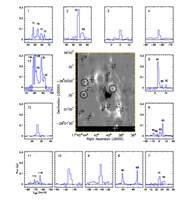 The authors present radio and infrared observations indicating ongoing star formation activity inside the ~2–5 pc circum-nuclear ring at the Galactic Center. Collectively these measurements suggest a continued disk-based mode of ongoing star formation has taken place near Sgr A* over the last few million years. VLA observations with 2.17 x 0.81 arcsec spatial resolution reveal 13 water masers, several of which have multiple velocity components. The presence of interstellar water masers suggests gas densities that are sufficient for self-gravity to overcome the tidal shear of the 4 x 106 M⊙ black hole., Spectral energy distribution modeling of stellar sources indicates massive young stellar object (YSO) candidates interior to the molecular ring, supporting in situ star formation near Sgr A* and appears to show a distribution similar to that of the counter-rotating disks of ~100 OB stars orbiting Sgr A*. Some YSO candidates have bow shock structures, suggesting that they have gaseous disks that are photo-evaporated and photo-ionized by the strong radiation field. The authors detect clumps of SiO (2-1) and (5-4) line emission in the ring based on CARMA observations. The FWHM and luminosity of the SiO emission is consistent with shocked protostellar outflows. Two linear ionized features with an extent of ~0.8 pc show blue and redshifted velocities between +50 and −40 km s−1, suggesting protostellar jet driven outflows with mass-loss rates of 5 x 10-5 M⊙. The authors also present the imprint of radio dark clouds at 44 GHz, representing a reservoir of molecular gas that feeds star formation activity close to Sgr A*.
The authors present radio and infrared observations indicating ongoing star formation activity inside the ~2–5 pc circum-nuclear ring at the Galactic Center. Collectively these measurements suggest a continued disk-based mode of ongoing star formation has taken place near Sgr A* over the last few million years. VLA observations with 2.17 x 0.81 arcsec spatial resolution reveal 13 water masers, several of which have multiple velocity components. The presence of interstellar water masers suggests gas densities that are sufficient for self-gravity to overcome the tidal shear of the 4 x 106 M⊙ black hole., Spectral energy distribution modeling of stellar sources indicates massive young stellar object (YSO) candidates interior to the molecular ring, supporting in situ star formation near Sgr A* and appears to show a distribution similar to that of the counter-rotating disks of ~100 OB stars orbiting Sgr A*. Some YSO candidates have bow shock structures, suggesting that they have gaseous disks that are photo-evaporated and photo-ionized by the strong radiation field. The authors detect clumps of SiO (2-1) and (5-4) line emission in the ring based on CARMA observations. The FWHM and luminosity of the SiO emission is consistent with shocked protostellar outflows. Two linear ionized features with an extent of ~0.8 pc show blue and redshifted velocities between +50 and −40 km s−1, suggesting protostellar jet driven outflows with mass-loss rates of 5 x 10-5 M⊙. The authors also present the imprint of radio dark clouds at 44 GHz, representing a reservoir of molecular gas that feeds star formation activity close to Sgr A*.
View Paper: Signatures of Young Star Formation Activity Within Two Parsecs of Sgr A*, F. Yusef-Zadeh (Northwestern), M. Wardle (Macquarie), M. Sewilo (SSI), D.A. Roberts (Northwestern), I. Smith (Macquarie), R. Arendt (NASA-GSFC), W. Cotton (NRAO), J. Lacy (Texas), S. Martin (IRAM), M.W. Pound (Maryland), M. Rickert (Northwestern), and M> royster (Northwestern), 2015 ApJ, 808, 97 (20 July 2015).
The Dynamics of the First Galaxies: [C II]
 The authors present analysis of an unusual [C II] emission line observed with ALMA in the very luminous quasi-stellar object (QSO) SDSS J155426.16+193703.0 at z ∼ 4.6. The line is extremely broad – full width at half-maximum 735 km/s – and appears to have a flat-topped or double-peaked line profile. A velocity map of the line shows a gradient across the source that indicates large-scale rotation of star-forming gas. Together, the velocity map and line profile suggest the presence of a massive rotating disc with a dynamical mass Mdyn ≳ 5 x 1010 M⊙. Using the assumption of a rotating disc origin, the authors employ an empirical relation between galaxy disc circular velocity and bulge velocity dispersion (σ) to estimate that σ > 310 km s−1, subject to a correction for the unknown disc inclination. This result implies that this source is consistent with the local M–σ relation, or offset at most by an order of magnitude in black hole mass. In contrast, the assumption of a bulge origin for the [C II] emission line would lead to a conclusion that the black hole is nearly two orders of magnitude more massive than predicted by the M–σ relation, similar to previous findings for other high-redshift QSOs. As disc rotation may be a common origin for [C II] emission at high redshifts, these results stress that careful consideration of dynamical origins is required when using observations of this line to derive properties of high-redshift galaxies.
The authors present analysis of an unusual [C II] emission line observed with ALMA in the very luminous quasi-stellar object (QSO) SDSS J155426.16+193703.0 at z ∼ 4.6. The line is extremely broad – full width at half-maximum 735 km/s – and appears to have a flat-topped or double-peaked line profile. A velocity map of the line shows a gradient across the source that indicates large-scale rotation of star-forming gas. Together, the velocity map and line profile suggest the presence of a massive rotating disc with a dynamical mass Mdyn ≳ 5 x 1010 M⊙. Using the assumption of a rotating disc origin, the authors employ an empirical relation between galaxy disc circular velocity and bulge velocity dispersion (σ) to estimate that σ > 310 km s−1, subject to a correction for the unknown disc inclination. This result implies that this source is consistent with the local M–σ relation, or offset at most by an order of magnitude in black hole mass. In contrast, the assumption of a bulge origin for the [C II] emission line would lead to a conclusion that the black hole is nearly two orders of magnitude more massive than predicted by the M–σ relation, similar to previous findings for other high-redshift QSOs. As disc rotation may be a common origin for [C II] emission at high redshifts, these results stress that careful consideration of dynamical origins is required when using observations of this line to derive properties of high-redshift galaxies.
View Paper: ALMA detection of a disc-dominated [C II] emission line at z=4.6 in the luminous QSO J1554+1937, Amy E. Kimball (CSIRO), Mark Lacy (NRAO), Carol J. Lonsdale (NRAO), and J.-P. Macquart (ICRAR, Curtin), 2015 MNRAS, 452, 88 (published online 1 July 2015).
Cataclysmic Variables Are Radio Sources
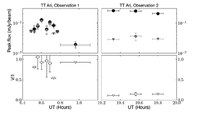 Radio emission from non-magnetic cataclysmic variables (CVs, accreting white dwarfs) could allow detailed studies of outflows and possibly accretion flows in these nearby, numerous and non-relativistic compact accretors. Until recently, however, very few CVs have been detected in the radio. Coppejans et al. have conducted a VLA pilot survey of four close and optically bright nova-like CVs at 6 GHz, detecting three, and thereby doubling the number of radio detections of these systems. These observations clearly show that the sensitivity of previous surveys was typically too low to detect these objects and that non-magnetic CVs can indeed be significant radio emitters. The three detected sources show a range of properties, including flaring and variability on both short (∼200 s) and longer-term (days) time-scales, as well as circular polarization levels of up to 100%. The spectral indices range from steep to inverted. This range of properties suggests that more than one emission process can be responsible for the radio emission in non-magnetic CVs. In this sample, the athors find that individual systems are consistent with optically thick synchrotron emission, gyrosynchrotron emission or cyclotron maser emission.
Radio emission from non-magnetic cataclysmic variables (CVs, accreting white dwarfs) could allow detailed studies of outflows and possibly accretion flows in these nearby, numerous and non-relativistic compact accretors. Until recently, however, very few CVs have been detected in the radio. Coppejans et al. have conducted a VLA pilot survey of four close and optically bright nova-like CVs at 6 GHz, detecting three, and thereby doubling the number of radio detections of these systems. These observations clearly show that the sensitivity of previous surveys was typically too low to detect these objects and that non-magnetic CVs can indeed be significant radio emitters. The three detected sources show a range of properties, including flaring and variability on both short (∼200 s) and longer-term (days) time-scales, as well as circular polarization levels of up to 100%. The spectral indices range from steep to inverted. This range of properties suggests that more than one emission process can be responsible for the radio emission in non-magnetic CVs. In this sample, the athors find that individual systems are consistent with optically thick synchrotron emission, gyrosynchrotron emission or cyclotron maser emission.
View Paper: Novalike Cataclysmic Variables are Signicant Radio Emitters, Deanne L. Coppejans (Radboud), Elmar G. Körding (Radboud), James C. A. Miller-Jones (Curtin), Michael P. Rupen (NRC-Herzberg), Christian Knigge (Southampton), Gregory R. Sivakoff (Alberta), and Paul J. Groot (Radboud), 2015 MNRAS, 451, 3801 (published online 29 June 2015).
ALMA Measures a Supermassive Black Hole Mass
 The dynamics of HCN and HCO+ in the inner few hundred parsecs of the nearby Type-1 Seyfert galaxy NGC 1097 have enabled the authors to determine a supermassive black hole (SMBH) mass of 1.4 x 108 M⊙. The measured SMBH mass is in good agreement with the SMBH mass and bulge velocity dispersion relationship. This result showcases ALMA’s potential for deriving accurate SMBH masses, especially for nearby late-type galaxies.
The dynamics of HCN and HCO+ in the inner few hundred parsecs of the nearby Type-1 Seyfert galaxy NGC 1097 have enabled the authors to determine a supermassive black hole (SMBH) mass of 1.4 x 108 M⊙. The measured SMBH mass is in good agreement with the SMBH mass and bulge velocity dispersion relationship. This result showcases ALMA’s potential for deriving accurate SMBH masses, especially for nearby late-type galaxies.
View Paper: A Measurement of the Black-Hole Mass in NGC 1097 Using ALMA, Kyoko Onishi (Sokendai, NAOJ), Satoru Iguchi (Sokendai, NAOJ), Kartik Sheth (NRAO), and Kotaro Kohno (Tokyo), 2015 ApJ, 806, 39 (10 June 2015).
The Dynamics of the First Galaxies: CO
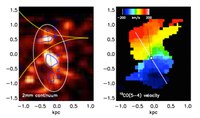 Swinbank et al exploit long baseline ALMA submillimeter observations of the lensed star-forming galaxy SDP 81 at z = 3.042 to investigate the properties of the interstellar medium (ISM) on scales of 50–100 pc. The kinematics of the 12CO gas within this system are well described by a rotationally supported disk with an inclination-corrected rotation speed 320 ± 20 km/s, and a dynamical mass of (3.5 ± 1.0) x 1010 M⊙ within a radius of 1.5 kpc. The disk is gas-rich and unstable and so collapse into star-forming regions with Jeans length ~ 130 pc. The authors identify five star-forming regions within the ISM on these scales and show that their scaling relations between luminosity, line widths, and sizes are significantly offset from those typical of molecular clouds in local galaxies. These offsets are likely to be caused by the high external hydrostatic pressure for the ISM, which is ~104x higher than the typical ISM pressure in the Milky Way. The physical conditions of the star-forming ISM and giant molecular clouds appear to be similar to those found in the densest environments in the local universe, such as those in the Galactic center.
Swinbank et al exploit long baseline ALMA submillimeter observations of the lensed star-forming galaxy SDP 81 at z = 3.042 to investigate the properties of the interstellar medium (ISM) on scales of 50–100 pc. The kinematics of the 12CO gas within this system are well described by a rotationally supported disk with an inclination-corrected rotation speed 320 ± 20 km/s, and a dynamical mass of (3.5 ± 1.0) x 1010 M⊙ within a radius of 1.5 kpc. The disk is gas-rich and unstable and so collapse into star-forming regions with Jeans length ~ 130 pc. The authors identify five star-forming regions within the ISM on these scales and show that their scaling relations between luminosity, line widths, and sizes are significantly offset from those typical of molecular clouds in local galaxies. These offsets are likely to be caused by the high external hydrostatic pressure for the ISM, which is ~104x higher than the typical ISM pressure in the Milky Way. The physical conditions of the star-forming ISM and giant molecular clouds appear to be similar to those found in the densest environments in the local universe, such as those in the Galactic center.
View Paper: ALMA Resolves the Properties of Star-forming Regions in a Dense Gas Disk at z ~ 3, A.M. Swinbank (Durham), S. Dye (Nottingham), J.W. Nightgale (Nottingham), C. Furlanetto (Nottingham, CAPES), Ian Smail (Durham), A. Cooray (Caltech), H. Dannerbauer (Wien), L. Dunne (Canterbury, Edinburgh), S. Eales (Cardiff), R. Gavazzi (Paris), T. Hunter (NRAO), R.J. Ivison (Edinburgh, ESO), M. Negrello (INAF), I. Oteo (Edinburgh, ESO), R. Smit (Durham), P. Van der Werf (Leiden), C. Vlahakis (JAO, ESO), 2015 ApJ Letters, 806, L17 (9 June 2015).
The Riddle of Infrared Faint Radio Sources
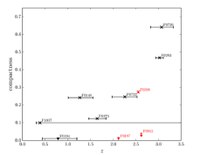 Infrared-faint radio sources (IFRS) form a new class of galaxies characterized by radio flux densities ~ milli-Janskys, with faint or absent infrared counterparts. It has been suggested that these objects are radio-loud active galactic nuclei (AGNs), at high redshift, although very young starburst galaxies at lower redshift cannot be ruled out. Herzog et al report the results of a 1.4 GHz VLBA survey of 57 IFRS at 10mas resolution and a sensitivity of ~ 60 micro-Jansky/beam rms. They detect compact cores in 35 of the 57 galaxies they surveyed. These results answer conclusively that IFRS are indeed radio AGN at substantial redshifts, and provide a sample of lower luminosity radio AGN to study in the distant Universe, possibly the youngest radio jet sources.
Infrared-faint radio sources (IFRS) form a new class of galaxies characterized by radio flux densities ~ milli-Janskys, with faint or absent infrared counterparts. It has been suggested that these objects are radio-loud active galactic nuclei (AGNs), at high redshift, although very young starburst galaxies at lower redshift cannot be ruled out. Herzog et al report the results of a 1.4 GHz VLBA survey of 57 IFRS at 10mas resolution and a sensitivity of ~ 60 micro-Jansky/beam rms. They detect compact cores in 35 of the 57 galaxies they surveyed. These results answer conclusively that IFRS are indeed radio AGN at substantial redshifts, and provide a sample of lower luminosity radio AGN to study in the distant Universe, possibly the youngest radio jet sources.
View Paper: Active galactic nuclei cores in infrared-faint radio sources: Very long baseline interferometry observations using the Very Long Baseline Array, A. Herzog (Bochum, Macquarie, CSIRO), E. Middelberg (Bochum), R.P. Norris (CSIRO), L.R. Spitler (Macquarie, AAO), A.T. Deller (ASTRON), J.D. Collier (Western Sydney, CSIRO), and Q.A. Parker (Macquarie, AAO), 2015 A&A, 578, A67 (published online 5 June 2015).
VLBA Images HI Clouds at z = 0.123
 Using long-slit optical spectra obtained with the 2-m telescope at IUCAA Girawali Observatory, the authors show that the radio source J094221.98+062335.2 (z = 0.123) is associated with a galaxy pair undergoing a major merger. Its companion is a normal star-forming galaxy infalling with a velocity of 185 km s−1at a projected separation of 4.8 kpc. Using the Westerbork Synthesis Radio Telescope (WSRT) and Giant Metrewave Radio Telescope (GMRT), Srianand et al detect a strong H I 21 cm absorption at the systemic redshift of the radio galaxy with N(HI) ∼ 9 × 1021 cm−2. Such a strong HI 21 cm absorption is rare and has been seen only in a few compact radio sources associated with similar merging galaxy pairs.
Using long-slit optical spectra obtained with the 2-m telescope at IUCAA Girawali Observatory, the authors show that the radio source J094221.98+062335.2 (z = 0.123) is associated with a galaxy pair undergoing a major merger. Its companion is a normal star-forming galaxy infalling with a velocity of 185 km s−1at a projected separation of 4.8 kpc. Using the Westerbork Synthesis Radio Telescope (WSRT) and Giant Metrewave Radio Telescope (GMRT), Srianand et al detect a strong H I 21 cm absorption at the systemic redshift of the radio galaxy with N(HI) ∼ 9 × 1021 cm−2. Such a strong HI 21 cm absorption is rare and has been seen only in a few compact radio sources associated with similar merging galaxy pairs.
Milliarcsecond resolution VLBA observations resolve the radio source into a compact symmetric object with the hotspot separation of 89 pc. The 21 cm absorption is detected in the VLBA spectra towards both the radio lobes, albeit with a strong optical depth gradient. The strong 21 cm absorption is consistent with it being arising from a clumpy circum-nuclear disc/torus. Two weaker absorption lines were also detected redshifted with respect to the radio source in the WSRT/GMRT spectrum. They probably represent cold (i.e. T ≤ 104 K) H I gas falling into the radio source. The presence of high concentration of H I gas in the circum-nuclear regions and signature of infalling cold gas suggests that the young radio source may have been triggered by the gas infall due to the ongoing merger.
View Paper: Circumnuclear and infalling H I gas in a merging galaxy pair at z = 0.123, R. Srianand (IUCAA), N. Gupta (IUCAA), E. Momjian (NRAO), and M. Vivek (Utah), 2015 MNRAS, 451, 917 (1 June 2015).
Imaging Filaments
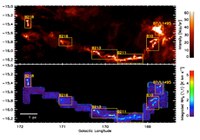 The authors present deep NH3 observations of the L1495-B218 filaments in the Taurus molecular cloud covering over a 3° angular range using the K-band focal plane array on the GBT. The L1495-B218 filaments form an interconnected, nearby, large complex extending over 8 pc. They observed NH3 (1, 1) and (2, 2) with a spectral resolution of 0.038 km/s and a spatial resolution of 31''. Most of the ammonia peaks coincide with intensity peaks in dust continuum maps at 350 and 500 μm. Physical properties are deduced by fitting a model to the observed spectra. These yield gas kinetic temperatures of 8–15 K, velocity dispersions of 0.05–0.25 km/s, and NH3 column densities of 5 x 1012 to 1 x 1014 cm−2. About 25% of the clumps are gravitationally bound and associated with star formation. The unbound clumps are mostly pressure confined. These data suggest that a dense core may form as a pressure-confined structure, evolve to a gravitationally bound core, and collapse to form a protostar.
The authors present deep NH3 observations of the L1495-B218 filaments in the Taurus molecular cloud covering over a 3° angular range using the K-band focal plane array on the GBT. The L1495-B218 filaments form an interconnected, nearby, large complex extending over 8 pc. They observed NH3 (1, 1) and (2, 2) with a spectral resolution of 0.038 km/s and a spatial resolution of 31''. Most of the ammonia peaks coincide with intensity peaks in dust continuum maps at 350 and 500 μm. Physical properties are deduced by fitting a model to the observed spectra. These yield gas kinetic temperatures of 8–15 K, velocity dispersions of 0.05–0.25 km/s, and NH3 column densities of 5 x 1012 to 1 x 1014 cm−2. About 25% of the clumps are gravitationally bound and associated with star formation. The unbound clumps are mostly pressure confined. These data suggest that a dense core may form as a pressure-confined structure, evolve to a gravitationally bound core, and collapse to form a protostar.
View Paper: An Ammonia Spectral Map of the L1495-B218 Filaments in the Taurus Molecular Cloud. I. Physical Properties of Filaments and Dense Cores, Young Min Seo (Arizona), Yancy L. Shirley (Arizona), Paul Goldsmith (JPL), Derek Ward-Thompson (Central Lancashire), Jason M. Kirk (Central Lancashire), Markus Schmalzl (Leiden), Jeong-Eun Lee (Kyung Hee), Rachel Friesen (Toronto), Glen Langston (NSF), Joe Masters (NRAO), Robert W. Garwood (NRAO), 2015 ApJ, 805, 185 (June 2015).
Low-mass Galaxy Evolution
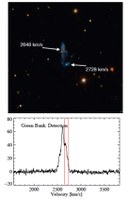 TiNy Titans (TNT) is the first systematic study of star formation and the subsequent processing of the interstellar medium in interacting dwarf galaxies. This paper presents the first results from a multi-wavelength observational program based on a sample of 104 dwarf galaxy pairs selected from a range of environments within the spectroscopic portion of the Sloan Digital Sky Survey and caught in various stages of interaction. The dwarf–dwarf merger sequence, as defined by TNT at z = 0, demonstrates conclusively that the star formation enhancement observed for massive galaxy pairs also extends to the dwarf mass range. Star formation is enhanced in paired dwarfs in otherwise isolated environments by 2.3x at pair separations <50 kpc relative to unpaired analogs. The enhancement decreases with increasing pair separation and extends out to pair separations as large as 100 kpc. Starbursts occur in 20% of the TNT dwarf pairs, regardless of environment, compared to just 6-8% of the matched unpaired dwarfs. Starbursts can be triggered throughout the merger and not just approaching coalescence. Despite their enhanced star formation and triggered starbursts, most TNT dwarf pairs have similar gas fractions relative to unpaired dwarfs of the same stellar mass. There may be significant reservoirs of diffuse, non-star-forming neutral gas surrounding the dwarf pairs, or the gas consumption timescales may be long in the starburst phase. The authors conclude that dwarf–dwarf interactions are significant drivers of galaxy evolution at the low-mass end, but ultimately environment is responsible for the quenching of star formation.
TiNy Titans (TNT) is the first systematic study of star formation and the subsequent processing of the interstellar medium in interacting dwarf galaxies. This paper presents the first results from a multi-wavelength observational program based on a sample of 104 dwarf galaxy pairs selected from a range of environments within the spectroscopic portion of the Sloan Digital Sky Survey and caught in various stages of interaction. The dwarf–dwarf merger sequence, as defined by TNT at z = 0, demonstrates conclusively that the star formation enhancement observed for massive galaxy pairs also extends to the dwarf mass range. Star formation is enhanced in paired dwarfs in otherwise isolated environments by 2.3x at pair separations <50 kpc relative to unpaired analogs. The enhancement decreases with increasing pair separation and extends out to pair separations as large as 100 kpc. Starbursts occur in 20% of the TNT dwarf pairs, regardless of environment, compared to just 6-8% of the matched unpaired dwarfs. Starbursts can be triggered throughout the merger and not just approaching coalescence. Despite their enhanced star formation and triggered starbursts, most TNT dwarf pairs have similar gas fractions relative to unpaired dwarfs of the same stellar mass. There may be significant reservoirs of diffuse, non-star-forming neutral gas surrounding the dwarf pairs, or the gas consumption timescales may be long in the starburst phase. The authors conclude that dwarf–dwarf interactions are significant drivers of galaxy evolution at the low-mass end, but ultimately environment is responsible for the quenching of star formation.
View Paper: TiNy Titans: The Role of Dwarf--Dwarf Interactions in Low-mass Galaxy Evolution, S. Stierwalt (UVA), G. Besla (Arizona), D. Patton (Trent), K. Johnson (UVA), N. Kallivayalil (UVA), M. Putnam (Columbia), G. Privon (UVA, Concepcion), and G. Ross (Trent), 2015 ApJ, 805, 2 (20 May 2015).




Connect with NRAO